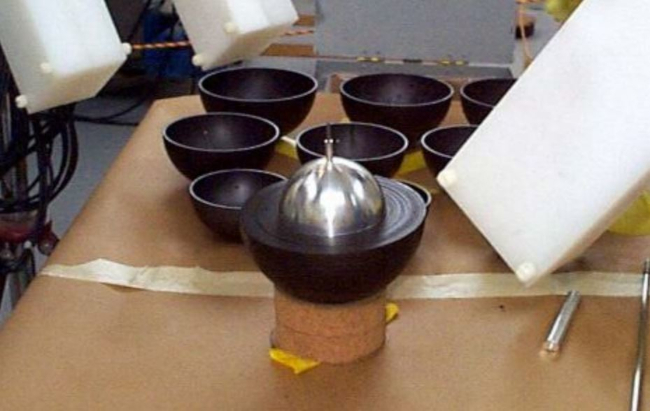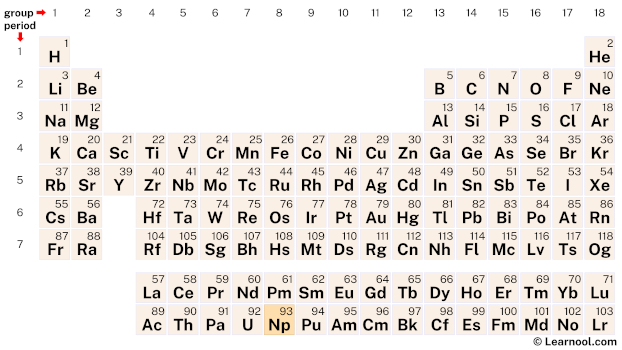
Neptunium (Np) is a chemical element of the periodic table, located in the period 7, and has the atomic number 93. It is the fifth element in the actinide series. It is a silvery metal which is named after the planet Neptune. It is the first transuranium element and is counted as one of the radioactive elements.
On periodic table
| group | ⇨ | 1 | 2 | 3 | 4 | 5 | 6 | 7 | 8 | 9 | 10 | 11 | 12 | 13 | 14 | 15 | 16 | 17 | 18 |
| period | ⇩ | ||||||||||||||||||
| 1 | 1 H  Hydrogen |
2 He  Helium |
|||||||||||||||||
| 2 | 3 Li  Lithium |
4 Be  Beryllium |
5 B  Boron |
6 C  Carbon |
7 N  Nitrogen |
8 O  Oxygen |
9 F  Fluorine |
10 Ne  Neon |
|||||||||||
| 3 | 11 Na  Sodium |
12 Mg  Magnesium |
13 Al  Aluminium |
14 Si Silicon |
15 P  Phosphorus |
16 S  Sulfur |
17 Cl  Chlorine |
18 Ar  Argon |
|||||||||||
| 4 | 19 K  Potassium |
20 Ca  Calcium |
21 Sc  Scandium |
22 Ti  Titanium |
23 V  Vanadium |
24 Cr  Chromium |
25 Mn  Manganese |
26 Fe  Iron |
27 Co  Cobalt |
28 Ni  Nickel |
29 Cu  Copper |
30 Zn  Zinc |
31 Ga  Gallium |
32 Ge  Germanium |
33 As  Arsenic |
34 Se  Selenium |
35 Br  Bromine |
36 Kr  Krypton |
|
| 5 | 37 Rb  Rubidium |
38 Sr  Strontium |
39 Y  Yttrium |
40 Zr  Zirconium |
41 Nb  Niobium |
42 Mo  Molybdenum |
43 Tc  Technetium |
44 Ru  Ruthenium |
45 Rh  Rhodium |
46 Pd  Palladium |
47 Ag  Silver |
48 Cd  Cadmium |
49 In  Indium |
50 Sn  Tin |
51 Sb  Antimony |
52 Te  Tellurium |
53 I  Iodine |
54 Xe  Xenon |
|
| 6 | 55 Cs  Caesium |
56 Ba  Barium |
72 Hf  Hafnium |
73 Ta  Tantalum |
74 W  Tungsten |
75 Re  Rhenium |
76 Os  Osmium |
77 Ir  Iridium |
78 Pt  Platinum |
79 Au  Gold |
80 Hg  Mercury |
81 Tl  Thallium |
82 Pb  Lead |
83 Bi  Bismuth |
84 Po  Polonium |
85 At  Astatine |
86 Rn  Radon |
||
| 7 | 87 Fr  Francium |
88 Ra  Radium |
104 Rf  Rutherfordium |
105 Db  Dubnium |
106 Sg  Seaborgium |
107 Bh  Bohrium |
108 Hs  Hassium |
109 Mt  Meitnerium |
110 Ds  Darmstadtium |
111 Rg  Roentgenium |
112 Cn  Copernicium |
113 Nh  Nihonium |
114 Fl  Flerovium |
115 Mc  Moscovium |
116 Lv  Livermorium |
117 Ts  Tennessine |
118 Og  Oganesson |
||
| 57 La  Lanthanum |
58 Ce  Cerium |
59 Pr  Praseodymium |
60 Nd  Neodymium |
61 Pm  Promethium |
62 Sm  Samarium |
63 Eu  Europium |
64 Gd  Gadolinium |
65 Tb  Terbium |
66 Dy  Dysprosium |
67 Ho  Holmium |
68 Er  Erbium |
69 Tm  Thulium |
70 Yb  Ytterbium |
71 Lu  Lutetium |
|||||
| 89 Ac  Actinium |
90 Th  Thorium |
91 Pa  Protactinium |
92 U  Uranium |
93 Np Neptunium |
94 Pu  Plutonium |
95 Am  Americium |
96 Cm  Curium |
97 Bk  Berkelium |
98 Cf  Californium |
99 Es  Einsteinium |
100 Fm  Fermium |
101 Md  Mendelevium |
102 No  Nobelium |
103 Lr  Lawrencium |
|||||
| – f block |
Neptunium is a member of the actinide series, a group of elements located at the bottom of the periodic table. It can be found in period 7, between uranium (U) and plutonium (Pu).
Element information
 |
|
 |
|
| Origin of name | named after planet Neptune |
| Symbol | Np |
| Atomic number (Z) | 93 |
| Atomic mass | (237) |
| Block | f-block |
| Period | 7 |
| Classification | Actinide |
| Atomic radius | 155 pm |
| Covalent radius | 190±1 pm |
| Melting point | 644 ℃, 1191 ℉, 917 K |
| Boiling point | 3902 ℃, 7056 ℉, 4175 K |
| Electron configuration | [Rn] 5f4 6d1 7s2 |
| Electrons per shell | 2, 8, 18, 32, 22, 9, 2 |
| Crystal structure | Orthorhombic |
| Phase at r.t | Solid |
| Density near r.t | 19.38 g/cm3 |
| Natural occurrence | From decay |
| Oxidation state | +5 |
| Electronegativity (Pauling scale) | 1.36 |
| Protons Neutrons Electrons |
93 144 93 |
| CAS number | 7439-99-8 |
| Discovered by | Edwin McMillan and Phillip H. Abelson in 1940 |
History
Neptunium is a synthetic element that was first discovered in 1940 by Edwin McMillan and Philip Abelson at the University of California, Berkeley. The discovery of neptunium was the result of a series of experiments in which uranium was bombarded with neutrons to create heavier elements.
In their experiments, McMillan and Abelson bombarded uranium with neutrons in a cyclotron and produced a new radioactive isotope. They identified this isotope as neptunium by comparing its radioactive properties with those of the element above uranium in the periodic table, which is named after the planet Neptune.
The discovery of neptunium was kept secret during World War Ⅱ, as it was considered a potential nuclear weapon material. However, in 1946, the discovery was declassified and announced to the world. Since its discovery, neptunium has been used mainly for scientific research purposes, and it has no practical applications outside of nuclear research.
Occurrence
Neptunium is a rare element that does not occur naturally in significant amounts in the Earth’s crust. All isotopes of neptunium have half-lives that are much shorter than the age of the Earth, meaning that any primordial neptunium should have decayed by now. Therefore, neptunium is present in nature only in trace amounts produced as intermediate decay products of other isotopes.
Despite its rarity, neptunium has been detected in various uranium ores, where it is found as a decay product from transmutation reactions. Neptunium-237 and Neptunium-239 are the most common isotopes found in nature, directly formed from neutron capture by uranium-238 atoms. These neutrons come from the spontaneous fission of uranium-238, naturally neutron-induced fission of uranium-235, cosmic ray spallation of nuclei, and light elements absorbing alpha particles and emitting a neutron.
Most neptunium that is encountered in the environment today is a result of atmospheric nuclear explosions that took place between the detonation of the first atomic bomb in 1945 and the ratification of the Partial Nuclear Test Ban Treaty in 1963. The total amount of neptunium released by these explosions is estimated to be around 2500 kg, and is primarily composed of the long-lived isotopes 236Np and 237Np. Additionally, a small amount of neptunium is created by neutron irradiation of natural uranium in nuclear reactor cooling water, which is then released into rivers or lakes.
Once released into the environment, neptunium generally oxidizes quickly, usually to the +4 or +5 state, and exhibits much greater mobility than other actinides due to its ability to readily form aqueous solutions with various other elements. This can lead to concerns over its potential migration and accumulation in various environments.
Production
Neptunium is an artificially produced element and is not found in nature in significant amounts. It can be produced through the nuclear transmutation of naturally occurring elements, such as uranium or plutonium. One common method of producing neptunium is through the irradiation of uranium-238 with neutrons. This process creates uranium-239, which undergoes beta decay to produce neptunium-239. The half-life of neptunium-239 is only 2.36 days, so it must be quickly isolated and purified for use.
Another method of producing neptunium is through the irradiation of plutonium-238 with neutrons. This process creates plutonium-239, which undergoes beta decay to produce neptunium-239 as well. The use of plutonium-238 in this process is advantageous because it has a much shorter half-life than uranium-238, allowing for faster production of neptunium-239.
Neptunium-237, another important isotope of neptunium, can be produced through the neutron capture of uranium-236. The half-life of neptunium-237 is 2.14 million years, making it useful for nuclear research and medical applications.
Properties
Physical properties
Neptunium is a silvery-white, metallic element that is radioactive and has a melting point of 644 ℃ and a boiling point of 3902 ℃. It is a ductile metal that can be easily shaped or molded.
Chemical properties
Neptunium is a highly reactive element that readily reacts with oxygen, water, and acids. It is known to form several oxidation states, ranging from +2 to +7, with +5 being the most stable state.
Radioactive properties
Neptunium is a radioactive element that emits both alpha and beta particles, as well as gamma rays. Its most stable isotope is neptunium-237, which has a half-life of 2.14 million years.
Nuclear properties
Neptunium has a high neutron capture cross-section and can be used in nuclear reactors to produce plutonium-238, which is used in radioisotope thermoelectric generators (RTGs).
Toxicity
Neptunium is a highly toxic element that can cause both chemical and radiological damage to living organisms. Due to its radioactivity and long half-life, it can remain hazardous for thousands of years.
Applications
Neptunium is not widely used due to its radioactivity and potential hazards. However, there are a few applications where it can be utilized:
Nuclear fuel: Neptunium-237 can be used as a nuclear fuel, but it is not currently used in commercial reactors due to its high radioactivity and long half-life.
Research: Neptunium-237 and its daughter products are used as radioactive tracers in scientific research, particularly in the fields of chemistry and nuclear physics.
Military: In the past, neptunium was used as part of the explosive component of certain types of nuclear weapons. However, this application is no longer in use.
Space exploration: Neptunium-237 has been proposed as a potential fuel for space exploration due to its high energy output, but this idea is still in the research and development stage.
Interesting facts
Neptunium is the first transuranium element to be discovered and it is named after the planet Neptune.
The most stable isotope of neptunium has a half-life of over 2 million years, making it an important element for long-term radioactive waste storage.
Neptunium was used in the first nuclear reactors built during World War Ⅱ and also in the development of nuclear weapons.
The element has potential applications in nuclear batteries and as a radiation source for medical purposes.
Neptunium has a silvery metallic appearance and is highly reactive with oxygen, nitrogen, and hydrogen.
It is a radioactive element and can emit alpha, beta, and gamma radiation.
Neptunium can be found in trace amounts in nature and is typically produced by neutron irradiation of uranium in nuclear reactors.
Due to its radioactivity and potential use in nuclear weapons, neptunium is tightly regulated and its use is strictly controlled.
Related
More elements
External links
- https://www.rsc.org/periodic-table/element/93/neptunium
- https://en.wikipedia.org/wiki/Neptunium
- https://www.britannica.com/science/neptunium
- https://www.chemicool.com/elements/neptunium.html
- https://www.livescience.com/39808-facts-about-neptunium.html
- https://pubchem.ncbi.nlm.nih.gov/element/Neptunium
- https://www.americanelements.com/np.html
Deep
Learnool.com was founded by Deep Rana, who is a mechanical engineer by profession and a blogger by passion. He has a good conceptual knowledge on different educational topics and he provides the same on this website. He loves to learn something new everyday and believes that the best utilization of free time is developing a new skill.
